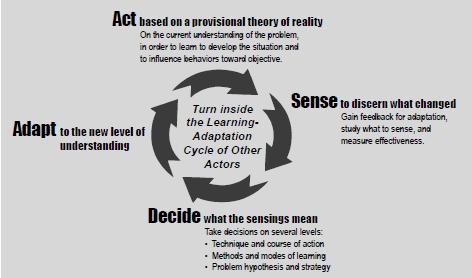|
p.2 Nearly all missions this century will be complex...
Operational artists at all levels need new conceptual tools commensurate to today's demands.
p.3 Human constructs are inherently fluid. Assigning mechanistic
predictability to them in doctrine amounts to erecting false assumptions as dogma... The last four years have seen
the Army promote studies to reinvigorate creativity, critical thinking, and adaptability as intellectual norms in a collective
organizational framework... This inquiry... has led it to examine what other disciplines and other militaries have learned
about dealing with the difficulties of novel and complex challenges... New systemic complexity defies the usual
approaches to sensemaking... Merely complicated systems are composed of numerous parts and structures, all logically
separable from their environment... Complex systems are made up of dynamic, interactive, and adaptive elements that
cannot be separated from interaction with their environments... Where merely complicated systems require mostly deduction
and analysis (formal logic of breaking into parts), complexity requires inductive and abductive reasoning for diagnostics
and synthesis... making sense of relationships requires hypothetical synthesis in the form of maps or narratives. Such maps
and narratives evolve as informal products that reflect a dimly perceived truth at a moment of understanding in time...
an appreciation for the dynamic flow of human factors and a bias toward perpetual learning and adapting.
[JLJ - Abductive reasoning starts when an inquirer considers of a set of
seemingly unrelated facts, armed with an intuition that they are somehow connected. ]
p.4 The U.S. military is not the only institution facing the conceptual
difficulties of complexity... The Australian Army has made adaptive campaigning a centerpiece of their doctrine.
In one sense this is an adaptation of John Boyd's OODA (observe, orient, decide, act) loop...
Adaptive campaigning is the art of continually making sense of dynamic situations and evolving designs,
plans, modes of learning, and actions to keep pace.
p.4 Consciously or not, all living beings and societies follow the
pattern of behavior described in the diagram below... They can be thought of as conducting one perpetual security
campaign in pursuit of desirable change. There is no beginning and no end state... What is actually attainable inevitably
changes as more is known. During the current extended campaigns, each combatant command is continually adapting within
the ecology of their environments, as do all living beings. Success depends on learning and adapting
more rapidly than rivals in the ecosystem.

p.5 we should treat our mental problem construct as a contingency.
Westerners often treat goals as conceptual ideals (as immutable realities), and consequently get wedded to plans that solve
expired problem frames. The advice of the Chinese sages is to treat problem frames as provisional landmarks on the road to
"better."... Because operational reality is complex, dynamic, and opaque, military commands should act on provisional
theories of reality (of the relation between truth and fact)... They should collectively develop a provisional road
to doing and making things better. The more comprehensive, relevant, and reliable knowledge is, the better the outcomes will
be... As aforementioned, operating headquarters are continually sensing to discern what has changed as a result
of its various interventions in the contextual ecosystem. Getting relevant feedback is challenging, as is learning
how and what to sense and how to identify useful measures of effectiveness... Another important function of design
is to devote attention and forethought to this sensing process. Ascribing meaning and relevance to information leading to
decisions about techniques and courses of action is not difficult.
p.6 An adaptive campaigning model is needed for modern doctrine... Every
time our framing of the problem changes, plans need to be updated - new problem, new solution... A complicated system behaves
in a linear, predictable fashion.
p.7 Current mission environments present complex rather
than complicated systems. They are marked by self-organization and something called "emergence"
- the capability to generate system changes without external input... Mapping such complexity is not true to reality
but an evanescently useful representation of reality. Keeping its transient quality in mind, any
competent leader armed with an understanding of the logic required could "set" and "solve" mission-problems within a framework
of adaptive campaigning.
p.8 Business literature has long advocated "management by walking around."...
Learning about complex situations is very much a bottom up process... Design should begin by constructing a broad conceptual
frame of reference, the "system frame."
p.10 Systemic changes (or disturbances) can produce an undesirable emergence.
p.11 This step of the
"journey of learning" addresses four important questions:
-
How elements of this system can combine efforts of actors...
to achieve comparative advantage.
-
How to create a networked system of collaboration to effectively
engage and sustain these varied potentials throughout the campaign...
-
How to exploit the self-defeating habits and tendencies of
particular adversaries...
-
How the command itself should organize to learn, adapt, and
continually re-design throughout the campaign.
|

